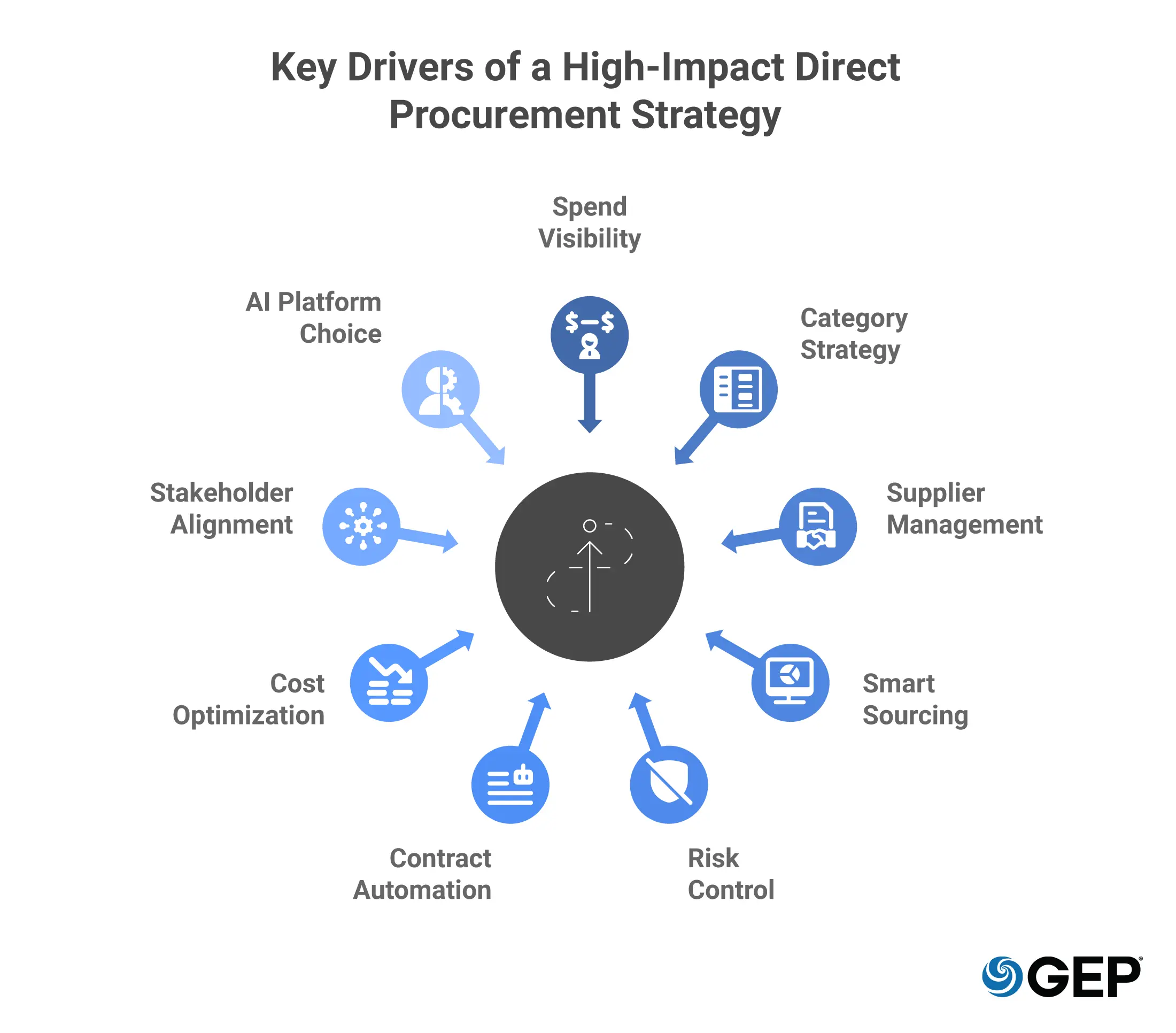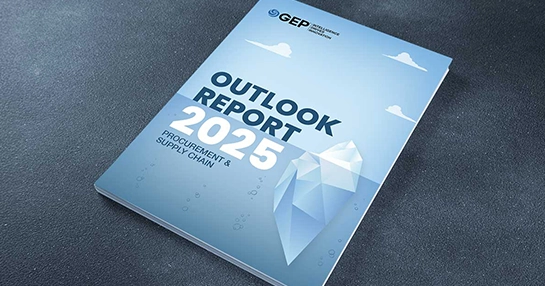
Key Elements of a Direct Procurement Strategy That Delivers (with Agentic AI)
- Focus on key pillars: data, suppliers, sourcing, risk, and cross-functional alignment.
- Use intelligent procurement platforms to collect and normalize internal systems and external market sources.
- Leverage agentic AI to optimize each pillar efficiently.
October 30, 2025 | Procurement Software 7 minutes read
Supply shocks are not unheard of in procurement. They disrupt raw material flows and weaken production. Political turmoil, trade conflicts, and climate events can suddenly cut off supplies, forcing you to balance cost, capacity, and delivery on tight timelines.
Scattered data and legacy systems, coupled with a lack of visibility and weak monitoring, drive production delays and eat into profit margins. Maverick spending and hidden risks follow.
An agentic AI system monitors these factors and aligns your procurement function to a single source of truth that runs on clear guardrails. It surfaces risks and triggers actions automatically, so problems are found and fixed earlier. This turns emergency responses into controlled, measurable procedures.
This article explains what direct procurement covers, why a formal strategy matters, and how Agentic AI powers the core elements of a cleverly thought-through direct procurement strategy.
What is Direct Procurement?
Direct procurement covers the parts and materials that become your finished goods. It drives production inputs that ultimately determine product cost and continuity. Its scope runs from early design and new product or service introduction to the receipt and payment of production-critical goods.
Because direct procurement depends on the cost of goods sold, failures here have a direct revenue impact and must be managed strategically.
Why Have a Direct Procurement Strategy?
A direct procurement strategy makes spending deliberate and predictable. It turns reactive buying into strategic value, so you capture cost savings and secure supply. With the right strategy, every dollar spent on production inputs supports margin and continuity goals.
How It Differs From Indirect Procurement
Direct procurement drives the cost of goods sold and production continuity, while indirect procurement manages operating expenses and support services. A small flaw in direct procurement can stop production. On the other hand, gaps in indirect spend primarily disrupt support functions.
When you formalize strategy across categories, suppliers, and risk, procurement shifts from cost control to protecting revenue and enabling growth.
Talk to our Expert
Key Elements of a Direct Procurement Strategy Using Agentic AI
To build a strategy that’s ‘future-proof,’ start with clear spend visibility and use agentic AI to automate insight and action. These are the core elements you need, and they show how agentic capabilities change execution.

Spend Analysis and Data Management
Collect, clean, and segment spending so you see where money flows and use agentic AI to categorize spending and forecast demand. You must centralize transaction data and standardize suppliers and part numbers before expecting reliable analytics.
Agentic AI cleans, classifies, and predicts. Agentic models reduce manual tagging and surface anomalies faster than manual review. With continuous feeds into a unified platform, you’ll spot leakage, tail spend, and consolidation opportunities early.
Accurate spend data is the foundation that makes every downstream decision faster and more reliable.
Category Management
Category strategy ties market dynamics to buying rules; data models keep it adaptive.
Craft category strategies that reflect market trends and demand, and let data models adjust those categories dynamically. Define objectives for each category — cost, availability, quality, or innovation — and set measurable KPIs.
Use agentic models to simulate sourcing scenarios and test the impact of changing specifications or safety stocks. Keep category plans short, update them often, and align inventory buffers to the margin impact of each category.
Dynamic category management reduces surprises and aligns buying to business priorities.
Supplier Relationship Management (SRM)
Not all suppliers are equal; segment and manage them by risk and value, using agentic scorecards. An SRM that’s data-led and automated keeps the best suppliers performing and reveals where replacements are needed.
Segment suppliers into strategic and tactical tiers and track performance with agentic AI scorecards and dashboards. Score suppliers on delivery, quality, financial health, and ESG measures so your engagement reflects risk and opportunity.
Agentic AI agents can monitor performance signals, trigger remediation workflows, and recommend escalation when metrics slip. Use that automation to keep supplier governance tight without overloading your team.
Strategic Sourcing
Source with a smart process that blends strategic thinking and automated execution. A disciplined sourcing engine reduces cycle time and raises the quality of supplier selection.
Run data-driven request-for-proposal (RFP) and related processes and use analytics to automate bidding and negotiation so you secure long-term value. Define sourcing windows and objectives, then use agentic systems to pre-qualify bidders and run scoring models.
AI agents can draft RFPs, evaluate proposals against should-cost models, and present shortlists for human negotiation. The process speeds procurement cycles and keeps decisions evidence-based.
Risk Management in Direct Procurement
Direct procurement directly impacts revenue, and so, the risks must be managed before they hit. Map the multi-tier network and use predictive analytics and agentic AI to spot weak links and run disruption simulations.
Predictive risk workflows keep you ahead of shocks and shorten response times.
Build a risk register that ties suppliers, sites, and raw materials to business impact metrics. Also run ‘what-if’ simulations that test the cost and schedule impact of supplier outages.
Agentic AI monitors external feeds and internal metrics. So when a trigger appears, it can create mitigation tasks, notify owners, and execute compensating actions like rerouting orders.
Contract Management and Compliance
Contracts are where commitments live. A contract holds pricing, delivery terms, exclusions, and penalties. Agentic AI in contract management enforces them and extracts value.
Agentic AI in the contract lifecycle can parse clauses, surface obligations, and tag milestone dates. It can compare proposed terms to your playbook, propose standard language, and route approvals to the right owner.
When a contract clause is at risk (e.g., late delivery, price variance, warranty claim, etc), the system alerts you and can trigger predefined remediation steps. Use these capabilities to reduce the manual review load and cut the risk of missed obligations.
Contract automation reduces leakage and enforces negotiated savings across the lifecycle. Apply Agentic AI in contract management to automate drafting, approvals, and compliance checks so contracts match policy.
Cost Optimization and Total Cost of Ownership (TCO)
Price is only one input. Factor inventory carrying costs, quality failure rates, import duties, and working capital into your models. Use should-cost models and total cost of ownership (TCO) calculators so decisions reflect lifecycle costs and hidden fees.
Agentic AI can run sensitivity tests across cost drivers to show where savings are sustainable rather than speculative. Combine those outputs with sourcing decisions to prioritize long-run value, not one-off discounts.
Knowing your TCO avoids short-term savings that eventually create unrequited long-term costs.
Is Tail Spend Draining Your Margins?
Learn how leading enterprises are cutting risk and boosting visibility with AI-driven strategies.
Internal Alignment and Communication
Shared data and clear incentives keep stakeholders rowing the same way.
Create a unified data platform and clear channels so finance, operations, and legal share the same goals. Alignment makes procurement’s gains visible and sustainable.
Set shared KPIs that reflect both margin and continuity, like amount spent under contract, on-time delivery, and TCO metrics. Use dashboards targeted at each stakeholder to show the impact of procurement actions in their language.
Agentic AI will push the relevant exceptions to the right people, keeping inbox noise low and decisions quick.
Choosing The Right Agentic AI Procurement Platform
Agentic AI lets you scale oversight without scaling headcount. The right platform will automate routine work, surface insight, and act on rules you set.
Deploy a flexible procurement platform where autonomous agents run RFQs, monitor suppliers, and execute contract lifecycle tasks. It extends contract capabilities into sourcing and supplier monitoring.
When configured with clear guardrails, agents reduce cycle time and elevate the humans who must negotiate, litigate, or redesign supply.
How Can Procurement Leaders Implement It Correctly?
Implementation is a disciplined sequence: define goals, pilot a high-value use case, then scale. Here’s how to get started:
- Set clear KPIs and value targets: Put numbers on cost, service, and compliance so success is measurable.
- Clean and centralize data: No agentic model helps if the data is inconsistent. Start small: one category or supplier group.
- Pilot an agentic use case: Automate one repetitive, high-impact process, and measure cycle time, error rate, and savings.
- Train users and update governance: Provide role-based training and set approval guardrails so humans remain in control.
- Scale iteratively: Expand from the pilot to neighboring categories, adjusting models and policies as you learn.
Be very specific with your goals, such as reducing material costs, sustainable sourcing, or enhancing on-time delivery. This will help you create a detailed plan with milestones, owners, and measurable outcomes that is aligned to broader company-wide goals.
Discover More: Direct Materials Procurement Services
Common Challenges and How To Address Them
Expect three pitfalls — poor data, resistance to change, and external volatility — and prepare countermeasures.
- Data quality and silos: Standardize taxonomy and let agentic AI normalize records. Without clean master data, analytics can mislead. Standardize part numbers and supplier IDs and run continuous reconciliation so analytics stay accurate.
- People and skills: Train staff on data literacy and create cross-functional teams to build trust between procurement and operations. Use AI to automate routine checks while running a training program that shows staff how AI reduces repetitive work.
- External volatility: Keep alternative suppliers and contract clauses that allow flexibility on volume and delivery. In contracts, include clear escalation paths and contingency terms; let agentic systems track triggers and automate notices.
Addressing these three areas makes strategy durable.
Conclusion
Direct procurement only delivers its full value when it’s run as a strategic system. Data, AI, supplier strategy, and contract discipline are the pillars; agentic AI amplifies each one.
Agentic AI in direct procurement transforms passive procurement into active processes that protect cost and business continuity. Define priorities, build data foundations, automate the source-to-pay lifecycle, and use agentic agents to monitor suppliers and processes and enforce terms.
Implementation requires leadership commitment, clear KPIs, and iterative pilots. This makes the result measurable: lower cost, fewer surprises, and stronger production continuity.
In a volatile market, continuity and margin protection define competitiveness. And agentic AI determines whether you are reacting to disruptions or running procurement as an engine for growth.
FAQ
Technology centralizes data and automates repetitive tasks. It also provides actionable insights. Intelligent platforms and agentic AI monitor suppliers and track spend, enforcing compliance and simulating risks.
All performance indicators must be defined around all your key procurement functions: cost efficiency, supplier quality, compliance, and operational efficiency. Break each category into specific, measurable KPIs that track performance and guide strategic decisions. Make sure they align with your business goals.
TCO measures the costs associated with the entire lifecycle of procuring a raw material or service.



